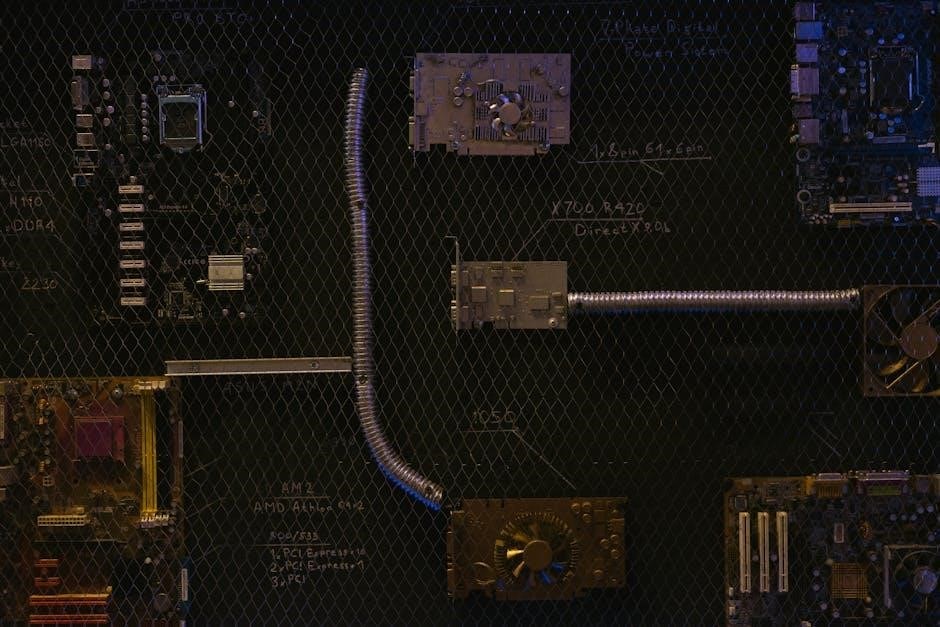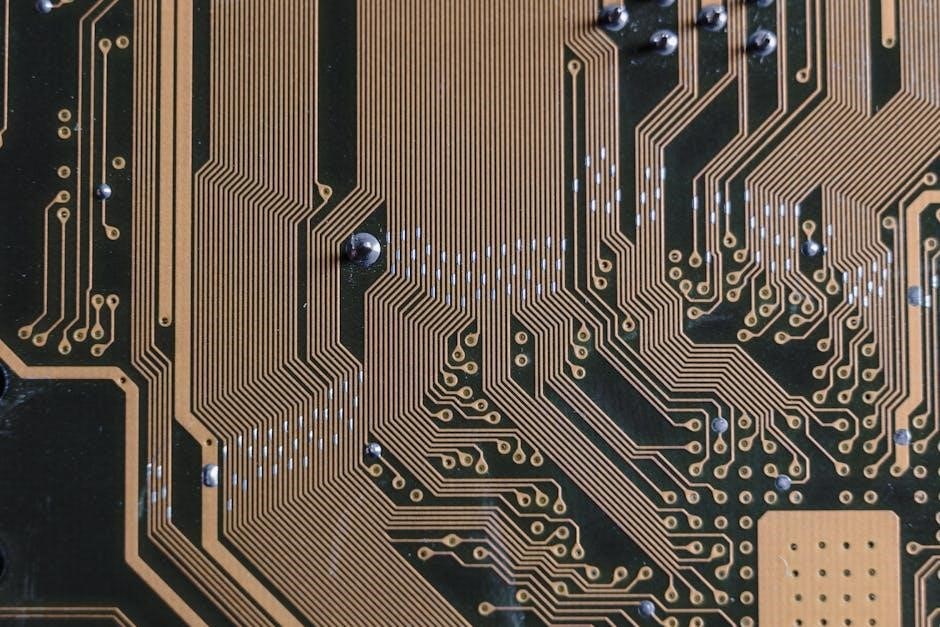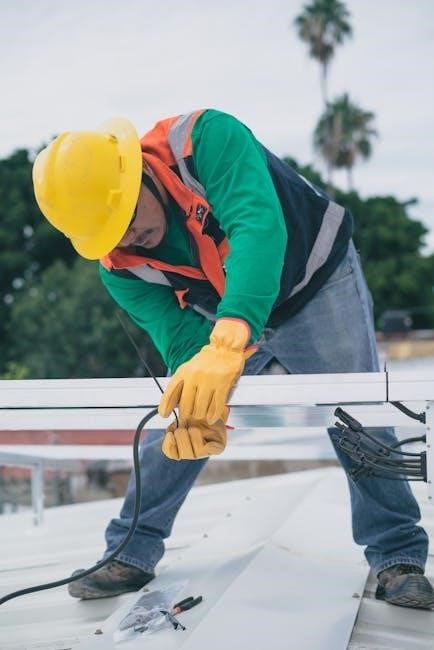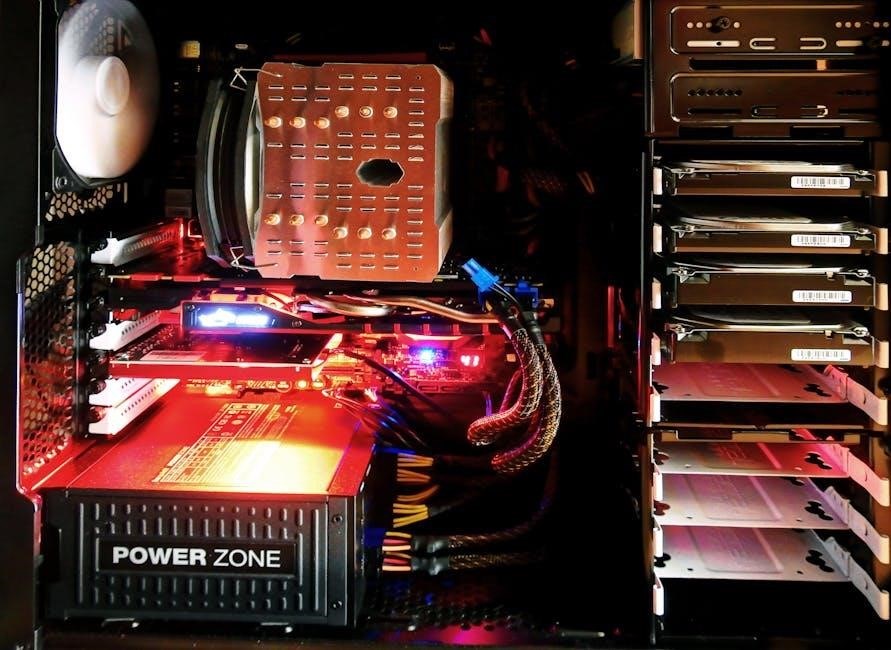
mitsubishi triton wiring diagram pdf
Download the Mitsubishi Triton wiring diagram PDF for free. Your comprehensive guide to electrical systems, perfect for DIY repairs and maintenance.
Wiring diagrams are visual guides detailing a vehicle’s electrical circuits, essential for installations, repairs, and diagnostics. They include symbols, color codes, and component connections, aiding professionals and DIYers in understanding and maintaining electrical systems effectively.
1.1 Importance of Wiring Diagrams for Vehicle Maintenance
Wiring diagrams are essential for maintaining and repairing modern vehicles like the Mitsubishi Triton. They provide a detailed visual representation of the electrical system, making it easier to identify components, connections, and potential issues. These diagrams help technicians and DIY enthusiasts diagnose problems efficiently, reducing repair time and costs. By understanding the wiring layout, users can avoid costly damage to the vehicle’s electrical systems. Whether troubleshooting faulty lights or resolving complex ECU-related issues, wiring diagrams are indispensable for ensuring safety and maintaining optimal vehicle performance. They are a critical resource for anyone working on the Mitsubishi Triton’s electrical systems.
1.2 Overview of Mitsubishi Triton Electrical Systems
The Mitsubishi Triton’s electrical system is a sophisticated network designed to power and control various vehicle functions. It includes components like the Engine Control Unit (ECU), sensors, actuators, and wiring harnesses. The system is modular, with circuits dedicated to functions such as ignition, lighting, and entertainment. Modern models incorporate advanced technologies like CAN bus communication for efficient data exchange between electronic control units. Understanding this system is crucial for troubleshooting and repairs, as it ensures proper operation of critical vehicle systems; The wiring diagram serves as a roadmap for diagnosing and maintaining these complex electrical connections.

Model-Specific Wiring Diagrams
Model-specific wiring diagrams for Mitsubishi Triton vary by year and model, ensuring accurate repairs and modifications. They detail unique electrical setups, crucial for precise troubleshooting and maintenance.
2.1 Mitsubishi Triton Models and Model Years (1996-2025)
Mitsubishi Triton models from 1996 to 2025 vary significantly, with distinct wiring diagrams for each generation. The first generation (1996-2005) includes the L200, while later models like the PA/PB (2005-2014) and current MK/MR (2015-2025) offer advanced electrical systems. Each model year has unique wiring configurations, reflecting updates in technology and design. Understanding the specific model and year is crucial for accurate wiring diagram selection, ensuring compatibility and safety during repairs or modifications. This section helps identify the correct diagram for your Triton, avoiding potential electrical issues.
2.2 Differences in Wiring Diagrams Across Model Years
Wiring diagrams for the Mitsubishi Triton vary significantly across model years due to technological advancements and design changes. Earlier models (1996-2005) feature simpler systems, while later generations (2005-2025) incorporate advanced electronics like CAN bus communication and driver-assistance systems. Modern diagrams include complex connections for features like touchscreen infotainment, lane departure warning, and automatic emergency braking. Additionally, hybrid and electric variants (2022-2025) introduce unique wiring for battery management and motor controls. These differences highlight the importance of using model-specific diagrams to avoid confusion and ensure accurate repairs.

Electrical Systems Overview
Mitsubishi Triton’s electrical systems include the battery, alternator, and ECU, which regulate power distribution. Wiring diagrams detail connections for lights, sensors, and essential vehicle functions, ensuring proper operation and maintenance.
3.1 Ignition System Wiring
The ignition system wiring in the Mitsubishi Triton connects the ignition coil, spark plugs, and engine control unit (ECU). The wiring diagram illustrates the flow of electrical signals, ensuring proper spark generation and timing. It also shows connections to the crankshaft and camshaft sensors, which synchronize engine operation. Damage to these wires can cause misfires or poor performance. The diagram aids in diagnosing issues like faulty ignition coils or loose connectors. Proper wiring ensures efficient combustion and smooth engine operation, making it essential for maintaining vehicle reliability and performance.
3.2 Lighting System Connections

The Mitsubishi Triton’s lighting system wiring connects headlights, taillights, turn signals, and interior lights to the vehicle’s electrical system. The wiring diagram details connections to fuses, relays, and switches, ensuring proper power distribution. It highlights circuits for high and low beams, fog lights, and brake lights, which are essential for safety. Damage to these connections can cause lighting failures, affecting visibility and safety. The diagram helps identify issues like blown fuses or faulty relays, guiding repairs to restore functionality. Accurate wiring ensures all lights operate correctly, maintaining safety and compliance with road regulations.
3.3 ECU and Sensor Integration
The Mitsubishi Triton’s wiring diagram outlines the integration of the Engine Control Unit (ECU) with various sensors, ensuring precise communication and control. Sensors like the oxygen sensor, crankshaft position sensor, and airflow sensor provide critical data to the ECU. This integration enables functions like fuel injection timing, emissions control, and engine performance optimization. The wiring diagram details how these sensors connect to the ECU, highlighting circuit paths and signal flows. Proper integration is vital for maintaining engine efficiency, reducing emissions, and enabling advanced diagnostics. This section is essential for understanding how the ECU manages the vehicle’s electrical and mechanical systems effectively.

Engine-Specific Wiring Diagrams
Engine-specific wiring diagrams provide detailed schematics for various Mitsubishi Triton engines, ensuring clarity and precision for repairs and modifications. These diagrams cover engine variants, connectors, and circuits, offering a comprehensive guide for mechanics and DIY enthusiasts to understand and work on the vehicle’s electrical systems effectively.
4.1 4D56 Engine Wiring Diagram
The 4D56 engine wiring diagram is a detailed schematic designed for the Mitsubishi Triton’s 2.5L turbo diesel engine. It outlines the electrical connections for fuel injection, sensors, and emissions systems. This diagram is crucial for diagnosing issues like faulty sensors or wiring malfunctions. Mechanics often use it to trace circuits and identify components. The 4D56 wiring diagram is complex, requiring a good understanding of electrical systems. It highlights the integration of the ECU with various sensors and actuators. For accurate repairs, consulting the diagram is essential. It also includes color-coded wires for easier identification of connections and components.
4;2 4M41 Engine Wiring Diagram
The 4M41 engine wiring diagram is tailored for the Mitsubishi Triton’s 3.2L diesel engine, known for its robust performance and fuel efficiency. This diagram provides a detailed layout of electrical connections for systems like fuel injection, emissions control, and sensors. It aids in diagnosing issues such as faulty injectors or sensor malfunctions. The wiring diagram highlights the complexity of modern diesel engine electronics, emphasizing the importance of proper connections for optimal operation. Mechanics rely on it to trace circuits and repair electrical faults accurately; Consulting the 4M41 wiring diagram ensures precise troubleshooting and maintenance of the engine’s advanced systems.
4.3 Other Engine Variants (4G63, 4G64)
The 4G63 and 4G64 engines, commonly found in Mitsubishi Triton models, offer distinct wiring diagrams due to their performance-oriented designs. The 4G63, a 2.0L turbocharged variant, features complex wiring for its intercooler and turbo systems. The 4G64, a naturally aspirated 2.4L engine, includes wiring for emissions control and fuel injection systems. Both diagrams detail connections for sensors, actuators, and engine management systems. These wiring layouts are essential for diagnosing issues like faulty oxygen sensors or turbocharger malfunctions. They also guide technicians in understanding the integration of advanced engine technologies, ensuring accurate repairs and maintenance for these powerful engine variants.

Troubleshooting Electrical Issues
Troubleshooting electrical issues in Mitsubishi Triton involves identifying faults in wiring, connectors, or components. Use diagrams to trace circuits, test connections, and isolate problems efficiently.
5.1 Common Electrical Problems in Mitsubishi Triton
Common electrical issues in Mitsubishi Triton include blown fuses, faulty relays, and corroded connectors. Problems often arise in lighting systems, wipers, and stereo connections. The ECU and sensors may malfunction, causing engine misfires or erratic behavior. Wiring harness damage, especially in 4WD models, can disrupt power distribution. Battery drain and faulty alternators are frequent complaints, while issues with the immobilizer and alarm systems can prevent ignition. Consulting the wiring diagram helps identify and resolve these issues efficiently, ensuring proper diagnosis and repair of electrical faults.
5.2 Using Wiring Diagrams for Diagnostic Procedures
Wiring diagrams are essential for diagnosing electrical issues in the Mitsubishi Triton. By analyzing the diagram, technicians can trace circuits, identify faulty components, and understand connectivity. Color-coded wires simplify tracking specific systems, while symbols clarify connections. For instance, if the headlights malfunction, the diagram helps locate the relevant circuit and test points. Using a multimeter, voltage drops can be measured to pinpoint issues like blown fuses or bad relays. This systematic approach ensures accurate troubleshooting, minimizing guesswork and reducing repair time. Always refer to the diagram before attempting any electrical repairs to ensure safety and precision.
5.3 Step-by-Step Repair Guides
Step-by-step repair guides are crucial for addressing electrical issues in the Mitsubishi Triton. Begin by identifying the fault using the wiring diagram to locate relevant circuits. Next, gather necessary tools, such as a multimeter and wiring connectors. Isolate the problematic area by disconnecting components and testing individual wires. Replace faulty parts, ensuring connections align with the diagram. Finally, reconnect and test the system to verify repairs. Always follow safety protocols, like disconnecting the battery, to prevent accidents. These guides ensure systematic and efficient resolutions, minimizing downtime and ensuring reliability.

Downloading the PDF
Download the Mitsubishi Triton wiring diagram PDF from official Mitsubishi sources or trusted third-party websites. Ensure the file is compatible with your vehicle’s model year for accuracy and safety.
6.1 Official Mitsubishi Sources
Access genuine Mitsubishi Triton wiring diagrams through official Mitsubishi sources. Visit the Mitsubishi Motors official website or contact authorized dealerships for authentic PDF downloads. These sources provide detailed, accurate wiring diagrams tailored to specific model years and variants. Ensure compatibility by selecting the correct Triton model and year. Official resources guarantee reliability and adherence to manufacturer standards, essential for safe and effective repairs. Always verify the source to avoid unauthorized or incorrect diagrams that may lead to improper installations or safety hazards.
6.2 Reliable Third-Party Websites
Reliable third-party websites offer authentic Mitsubishi Triton wiring diagrams in PDF format. Platforms like AutoZone, O’Reilly Auto Parts, and AllData provide access to detailed diagrams. These sites often require a subscription or one-time purchase but ensure high-quality, accurate information. Verify the website’s credibility to avoid counterfeit or incomplete diagrams. Some forums and enthusiast communities also share verified wiring diagrams, though caution is advised. Always cross-check with official Mitsubishi sources to ensure accuracy and compatibility with your specific Triton model year.
6.4 Free vs. Paid Resources
When seeking Mitsubishi Triton wiring diagrams, users can choose between free and paid resources. Free options, such as forums or unofficial websites, may offer basic diagrams but often lack detail or accuracy. Paid resources, like official Mitsubishi manuals or professional databases, provide comprehensive, high-quality diagrams tailored to specific models. While free resources save money, they may not cover complex systems or newer models. Paid options ensure reliability and completeness, making them ideal for critical repairs; Consider your needs and budget when deciding between these options to ensure you get the right wiring diagram for your Mitsubishi Triton.

Reading and Interpreting Diagrams
Understand the basics of wiring diagrams, including symbols, color codes, and connections. Cross-reference components with the legend to avoid confusion and trace circuits systematically for clarity.
7.1 Understanding Symbols and Color Codes
Mastering symbols and color codes is crucial for interpreting Mitsubishi Triton wiring diagrams. Symbols represent components like batteries, fuses, and ECUs, while colors indicate wire functions, such as red for power, black for ground, and yellow for signal. Standardized symbols ensure consistency, while color codes help trace circuits quickly. Familiarize yourself with the legend provided in the PDF to decode each element accurately. This understanding is vital for diagnosing issues, ensuring repairs are done safely and efficiently. Always cross-reference symbols and colors with the diagram’s key to avoid misidentification and potential electrical damage.
7.2 Identifying Components and Connections
Identifying components and connections in a Mitsubishi Triton wiring diagram requires careful attention to detail. Components like ECUs, sensors, and actuators are labeled clearly, while connections are shown via lines indicating wire routes. Each component is represented by standardized symbols, and connections are color-coded or numbered for clarity. Use the diagram’s component list to locate specific parts and trace connections systematically. This helps in understanding how systems interact and pinpointing potential issues. Always cross-reference with the legend for accurate identification, ensuring repairs are precise and safe. Familiarity with these connections is key to diagnosing and resolving electrical system problems effectively.

Safety Tips and Precautions
Always disconnect the battery before working on electrical systems. Wear protective gear and avoid shortcuts. Be cautious with sensitive electronics to prevent damage or injury.
8.1 Essential Safety Measures
When working with your Mitsubishi Triton’s wiring diagram, always disconnect the battery to prevent electrical shocks. Wear protective gloves and goggles to safeguard against potential hazards. Use proper tools designed for electrical work to avoid damaging components. Ensure the vehicle is on level ground and apply the parking brake. Never work near open flames or sparks, as this could ignite flammable gases. Ground the vehicle to prevent static electricity damage. Avoid touching live wires or components to prevent injury. Always refer to the wiring diagram for accurate connections and procedures. Ensure good lighting to clearly see components and connections.
8.2 Best Practices for Electrical Work

When performing electrical work on your Mitsubishi Triton, always follow the wiring diagram precisely to avoid mismatches. Use high-quality tools and materials to ensure reliable connections. Test components before reassembling to confirm functionality. Label wires and connections for future reference. Avoid overloading circuits, as this can cause damage or fires. Use the correct wire gauge for the application to prevent overheating. Double-check all connections for tightness and security. Regularly inspect wiring for signs of wear or damage; Keep a multimeter handy for voltage and continuity testing. Document any modifications for future maintenance. Always consult the wiring diagram before making changes.
9.1 Summary of Key Points
Understanding the Mitsubishi Triton wiring diagram is crucial for effective vehicle maintenance and repairs. It provides a detailed visual representation of electrical systems, including ignition, lighting, and ECU connections. Model-specific diagrams vary across years, ensuring accuracy for repairs. Troubleshooting common issues like faulty sensors or wiring faults is simplified with these diagrams. Always prioritize safety, such as disconnecting the battery before work. Downloading the PDF from official Mitsubishi sources or trusted third-party sites ensures reliability. For further guidance, consult additional resources like repair manuals or forums dedicated to Mitsubishi Triton owners.
9.2 Further Reading and Resources
For deeper insights, explore official Mitsubishi repair manuals and technical bulletins, which provide detailed instructions and diagrams. Dedicated forums and YouTube channels offer practical guides, real-world examples, and expert advice. Additionally, consider purchasing detailed workshop manuals or subscribing to automotive databases for comprehensive wiring diagram access. These resources provide advanced troubleshooting techniques, in-depth system understanding, and step-by-step repair guides, ensuring accurate repairs and maintenance for your Mitsubishi Triton. Engaging with these materials will enhance your DIY capabilities, reduce repair costs, and ensure your vehicle operates at peak performance. Moreover, staying updated with the latest resources helps in tackling newer models and updated systems effectively, keeping your Triton in optimal condition.
- Official Mitsubishi repair manuals
- Technical service bulletins
- Specialized automotive forums
- YouTube tutorials
- Premium workshop manuals
- Automotive database subscriptions